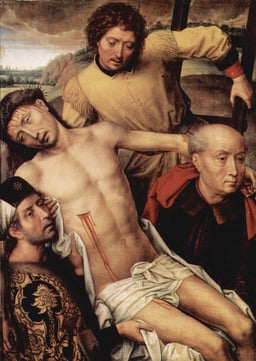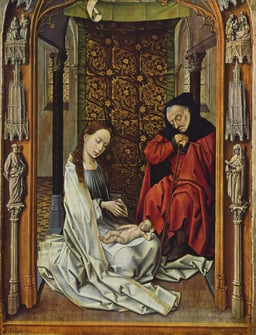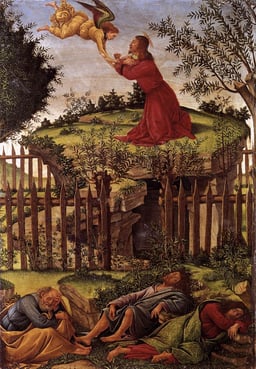Granada
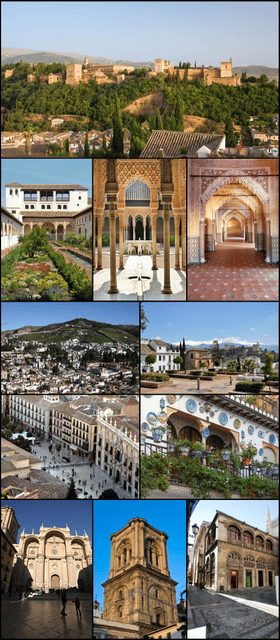
Granada

| Coordinates: | |
| Country | Spain |
|---|---|
| Autonomous Community | Andalusia |
| Province | Granada |
| Comarca | Vega de Granada |
| Government | |
| • Type | Mayor-council |
| • Body | Ayuntamiento de Granada |
| •Mayor | Luis Salvador (Cs) |
| Area | |
| • Total | 88.02 km(33.98 sq mi) |
| Elevation | 738 m (2,421 ft) |
| Population | |
| • Total | 232,208 |
| • Density | 2,600/km(6,800/sq mi) |
| Demonyms | granadino(),granadina()iliberitano(),iliberitana(),granadí,garnatí |
| Time zone | UTC+1(CET) |
| UTC+2(CEST) | |
| Postal codes | |
| Area code(s) | +34(Spain) + (Granada) |
| Website | |
Granada (/ɡrəˈnɑːdə/ grə-NAH-də, Spanish: [ɡɾaˈnaða])[1] is the capital city of the province of Granada, in the autonomous community of Andalusia, Spain. Granada is located at the foot of the Sierra Nevada mountains, at the confluence of four rivers, the Darro, the Genil, the Monachil and the Beiro. It sits at an average elevation of 738 m (2,421 ft) above sea level, yet is only one hour by car from the Mediterranean coast, the Costa Tropical. Nearby is the Sierra Nevada Ski Station, where the FIS Alpine World Ski Championships 1996 were held.
In the 2005 national census, the population of the city of Granada proper was 236,982, and the population of the entire urban area was estimated to be 472,638, ranking as the 13th-largest urban area of Spain. About 3.3% of the population did not hold Spanish citizenship, the largest number of these people (31%; or 1% of the total population) coming from South America. Its nearest airport is Federico García Lorca Granada-Jaén Airport.
The Alhambra, an Arab citadel and palace, is located in Granada. It is the most renowned building of the Islamic historical legacy with its many cultural attractions that make Granada a popular destination among the tourist cities of Spain. The Almohad influence on architecture is also preserved in the Granada neighborhood called the Albaicín with its fine examples of Moorish and Morisco construction. Granada is also well-known within Spain for the University of Granada which has an estimated 82,000 students spread over five different campuses in the city. The pomegranate (in Spanish, granada) is the heraldic device of Granada.
| Coordinates: | |
| Country | Spain |
|---|---|
| Autonomous Community | Andalusia |
| Province | Granada |
| Comarca | Vega de Granada |
| Government | |
| • Type | Mayor-council |
| • Body | Ayuntamiento de Granada |
| •Mayor | Luis Salvador (Cs) |
| Area | |
| • Total | 88.02 km(33.98 sq mi) |
| Elevation | 738 m (2,421 ft) |
| Population | |
| • Total | 232,208 |
| • Density | 2,600/km(6,800/sq mi) |
| Demonyms | granadino(),granadina()iliberitano(),iliberitana(),granadí,garnatí |
| Time zone | UTC+1(CET) |
| UTC+2(CEST) | |
| Postal codes | |
| Area code(s) | +34(Spain) + (Granada) |
| Website | |
History
Pre-Umayyad history
The region surrounding what today is Granada has been populated since at least 5500 BC and experienced Roman and Visigothic influences. The most ancient ruins found in the city belong to an Iberian oppidum called Ilturir, in the region known as Bastetania. This oppidum eventually changed its name to Iliberri, and after the Roman conquest of Iberia, to Municipium Florentinum Iliberitanum.[6]
Founding and early history
The Umayyad conquest of Hispania, starting in AD 711, brought large parts of the Iberian Peninsula under Moorish control and established al-Andalus. Granada's historical name in the Arabic language was غرناطة (Ġarnāṭah).[6][7][8][9] The word Gárnata (or Karnatah) possibly means "hill of strangers". Because the city was situated on a low plain and, as a result, difficult to protect from attacks, the ruler decided to transfer his residence to the higher situated area of Gárnata. In a short time this town was transformed into one of the most important cities of al-Andalus.[6][8]
In the early 11th century, after the collapse of the Umayyad Caliphate, the Berber Zawi ben Ziri established an independent kingdom for himself, the Taifa of Granada. His surviving memoirs — the only ones for the Spanish "Middle Ages"[10] — provide considerable detail for this brief period. The Zirid Taifa of Granada was a Jewish state in all but name; the Muslim king is looked upon as a mainly symbolic figurehead. It was the center of Jewish Sephardi culture and scholarship.
Early Arabic writers repeatedly called it "Garnata al-Yahud" (Granada of the Jews)....
Granada was in the eleventh century the center of Sephardic civilization at its peak, and from 1027 until 1066 Granada was a powerful Jewish state.
Jews did not hold the foreigner (dhimmi) status typical of Islamic rule. Samuel ibn Nagrilla, recognized by Sephardic Jews everywhere as the quasi-political ha-Nagid ('The Prince'), was king in all but name. As vizier he made policy and—much more unusual—led the army.... It is said that Samuel’s strengthening and fortification of Granada was what permitted it, later, to survive as the last Islamic state in the Iberian peninsula.
All of the greatest figures of eleventh-century Hispano-Jewish culture are associated with Granada.
Moses Ibn Ezra was from Granada; on his invitation Judah ha-Levi spent several years there as his guest. Ibn Gabirol’s patrons and hosts were the Jewish viziers of Granada, Samuel ha-Nagid and his son Joseph.[11]
When Joseph took over after his father's death, he proved to lack his father's diplomacy, bringing on the 1066 Granada massacre, which ended the Golden Age of Jewish Culture in Spain.
Nasrid dynasty—Emirate of Granada
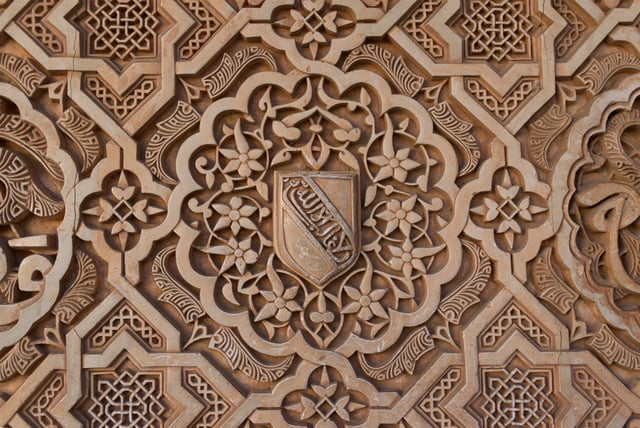
Coat of arms of the Nasrid Kingdom of Granada in the Palacio de Comares room in the Alhambra.
In 1228, with the departure of the Almohad prince Idris al-Ma'mun, who left Iberia to take the Almohad leadership, the ambitious Ibn al-Ahmar established the last and longest reigning Muslim dynasty in the Iberian peninsula, the Nasrids. With the Reconquista in full swing after the conquest of Córdoba in 1236, the Nasrids aligned themselves with Fernando III of Castile, officially becoming the Emirate of Granada in 1238.[13] According to some historians, Granada was a tributary state to the Kingdom of Castile from that year. It provided connections with Muslim and Arab trade centers, particularly for gold from sub-Saharan Africa and the Maghreb, and exported silk and dried fruits produced in the area.[14] The Nasrids also supplied troops from the Emirate and mercenaries from North Africa for service to Castile.
Ibn Battuta, a famous traveller and an authentic historian, visited the Kingdom of Granada in 1350. He described it as a powerful and self-sufficient kingdom in its own right, although frequently embroiled in skirmishes with the Kingdom of Castile. In his journal, Ibn Battuta called Granada the “metropolis of Andalusia and the bride of its cities.”[15]
Reconquista and the 16th century
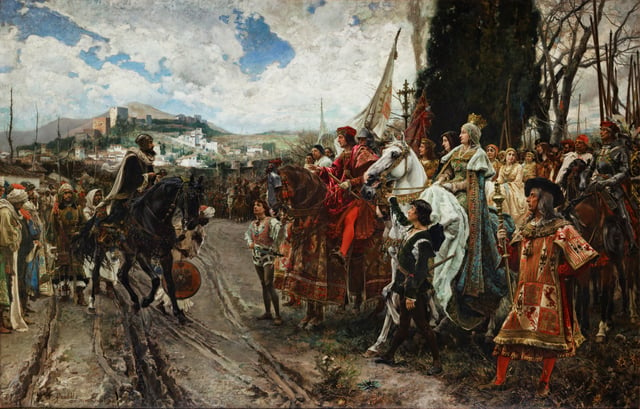
The Capitulation of Granada by F. Padilla: Muhammad XII before Ferdinand and Isabella (circa 1882).
On January 2, 1492, the last Muslim ruler in Iberia, Emir Muhammad XII of Granada, known as "Boabdil" to the Spanish, surrendered complete control of the Emirate of Granada to Ferdinand II of Aragon and Isabella I of Castile, Los Reyes Católicos ("the Catholic Monarchs"), after the last battle of the Granada War.
The 1492 surrender of the Kingdom of Granada to the Catholic Monarchs is one of the most significant events in Granada's history as it marks the completion of the Reconquista. The terms of the surrender, expressed in the Alhambra Decree treaty, explicitly allowed the city's Muslim inhabitants, known as Mudéjars, to continue unmolested in the practice of their faith and customs. By 1499, however, Cardinal Francisco Jiménez de Cisneros grew frustrated with the slow pace of the efforts of the first archbishop of Granada, Hernando de Talavera, to convert non-Christians to Christianity and undertook a program of forced Christian baptisms, creating the Converso (convert) class for Muslims and Jews. Cisneros's new tactics, which were a direct violation of the terms of the treaty, provoked the Rebellion of the Alpujarras (1568–71) centered in the rural Alpujarras region southwest of the city.
Responding to the rebellion of 1501, the Castilian Crown rescinded the Alhambra Decree treaty, and mandated that Granada's Muslims convert or emigrate.
Under the 1492 Alhambra Decree, Spain's Jewish population, unlike the Muslims, had already been forced to convert under threat of expulsion or even execution, becoming Marranos (meaning "pigs" in Spanish), or Catholics of Jewish descent. Many of the elite Muslim class subsequently emigrated to North Africa. The majority of the Granada's Mudéjar Muslims converted so that they could stay, however, becoming Moriscos, or Catholics of Moorish descent ("Moor" being equivalent to Muslim). Both populations of conversos
Over the course of the 16th century, Granada took on an ever more Catholic and Castilian character, as immigrants came to the city from other parts of the Iberian Peninsula.
The city's mosques were converted to Christian churches or completely destroyed. New structures, such as the cathedral and the Chancillería, or Royal Court of Appeals, transformed the urban landscape. After the 1492 Alhambra decree, which resulted in the majority of Granada's Jewish population being expelled, the Jewish quarter (ghetto) was demolished to make way for new Catholic and Castilian institutions and uses.
Legacy
The fall of Granada has a significant place among the important events that mark the latter half of the Spanish 15th century. It completed the so-called "Reconquista" (or Christian reconquest) of the almost 800-year-long Islamic rule in the Iberian Peninsula. Spain, now without any major internal territorial conflict, embarked on a great phase of exploration and colonization around the globe. In the same year, the sailing expedition of Christopher Columbus resulted in what is usually claimed to be the first European sighting of the New World, although Leif Erikson is often regarded as the first European to land in the New World, 500 years before Christopher Columbus. The resources of the Americas enriched the crown and the country, allowing Queen Isabella and King Ferdinand to consolidate their rule as Catholic Monarchs of the united kingdoms. Subsequent conquests, and the Spanish colonization of the Americas by the maritime expeditions they commissioned, created the vast Spanish Empire: for a time, the largest in the world.
Heritage and monuments
The greatest artistic wealth of Granada is its Spanish-Islamic art — in particular, the compound of the Alhambra and the Generalife. The Generalife is a pleasure palace with attached romantic gardens, remarkable both for its location and layout, as well as for the diversity of its flowers, plants and fountains. The Alhambra is the architectural culmination of the works of Nasrid art that were undertaken in the 13th and 14th centuries, with most of the Alhambra having been built at the time of Yusuf I and Mohammed V, between 1333 and 1354.
At present, the buildings of Granada are typically bourgeois in appearance, with much of the architecture dating from the 19th Century, together with numerous Renaissance and Baroque buildings.
The Alhambra
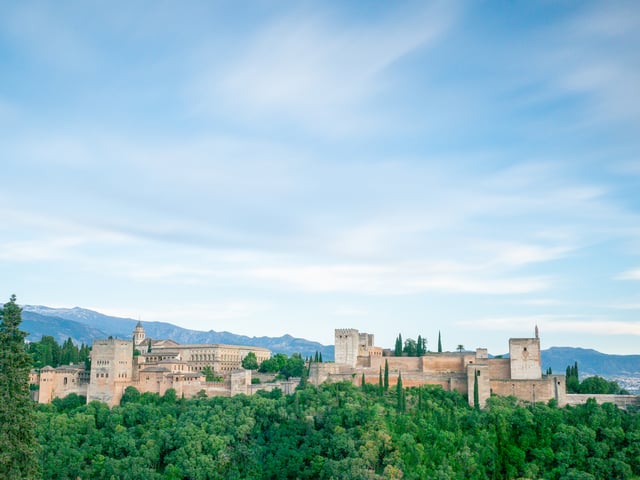
The view of the Alhambra from the Albaicín

The view of the Albaicín from Granada
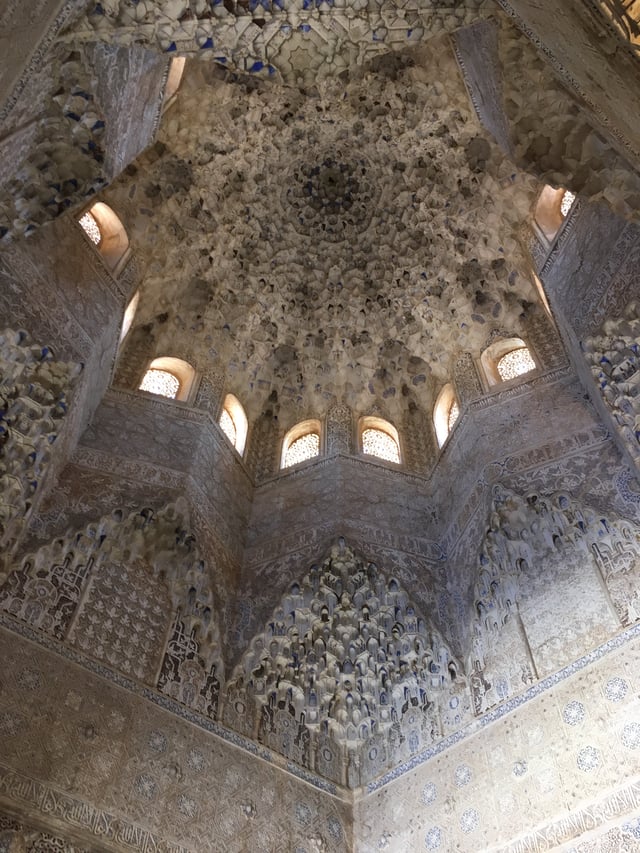
Nasrid Palaces, Alhambra complex
The Alhambra is a Nasrid "palace city".
It was declared a World Heritage site by UNESCO in 1984. It is certainly Granada's most emblematic monument and one of the most visited in Spain. It consists of a defensive zone, the Alcazaba, together with others of a residential and formal state character, the Nasrid Palaces and, lastly, the palace, gardens and orchards of the Generalife.
The Alhambra occupies a small plateau on the southeastern border of the city in the foothills of the Sierra Nevada above the Assabica valley. Some of the buildings may have existed before the arrival of the Moors. The Alhambra as a whole is completely walled, bordered to the north by the valley of the Darro, to the south by the al-Sabika, and to the east of the Cuesta del Rey Chico, which in turn is separated from the Albaicín and Generalife, located in the Cerro del Sol.
In the 11th century the Castle of the Alhambra was developed as a walled town which became a military stronghold that dominated the whole city.
But it was in the 13th century, with the arrival of the first monarch of the Nasrid dynasty, Muhammad I of Granada (Mohammed I, 1238–1273), that the royal residence was established in the Alhambra. This marked the beginning of its heyday. The Alhambra became palace, citadel and fortress, and was the residence of the Nasrid sultans and their senior officials, including servants of the court and elite soldiers (13th–14th centuries).
In 1492 the Catholic Monarchs, Ferdinand and Isabela, expelled the final Moors from the city of Granada. They established permanent residency in the Alhambra, and it was here that Christopher Columbus requested royal endorsement for his westward expedition that year.
In 1527 Charles V, Holy Roman Emperor demolished part of the architectural complex to build the Palace which bears his name. Although the Catholic Monarchs had already altered some rooms of the Alhambra after the conquest of the city in 1492, Charles V wanted to construct a permanent residence befitting an emperor. Around 1537 he ordered the construction of the Peinador de la Reina, or Queen's dressing room, where his wife Isabel lived, over the Tower of Abu l-Hayyay.
There was a pause in the ongoing maintenance of the Alhambra from the 18th century for almost a hundred years, and during control by the First French Empire, substantial portions of the fortress were blown apart. The repair, restoration and conservation that continues to this day did not begin until the 19th century. The complex currently includes the Museum of the Alhambra, with objects mainly from the site of the monument itself and the Museum of Fine Arts.[17]
Generalife
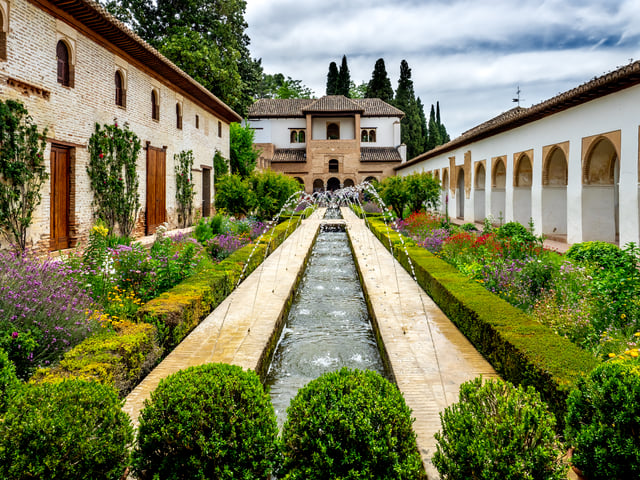
Generalife Fountains
The Generalife is a garden area attached to the Alhambra which became a place of recreation and rest for the Granadan Muslim kings when they wanted to flee the tedium of official life in the Palace. It occupies the slopes of the hill Cerro del Sol above the ravines of the Genil and the Darro and is visible from vantage points throughout the city. It was conceived as a rural village, consisting of landscaping, gardens and architecture. The palace and gardens were built during the reign of Muhammed III (1302–1309) and redecorated shortly after by Abu l-Walid Isma'il (1313–1324). It is of the Islamic Nasrid style, and is today one of the biggest attractions in the city of Granada. The Generalife was declared a World Heritage Site by UNESCO in 1984.
It is difficult to know the original appearance of the Generalife, as it has been subject to modifications and reconstructions throughout the Christian period which disfigured many of its former aspects.
All buildings of the Generalife are of solid construction, and the overall decor is austere and simple.
There is little variety to the Alhambra's decorative plaster, but the aesthetic is tasteful and extremely delicate. In the last third of the 20th century, a part of the garden was destroyed to build an auditorium.[18]
Cathedral
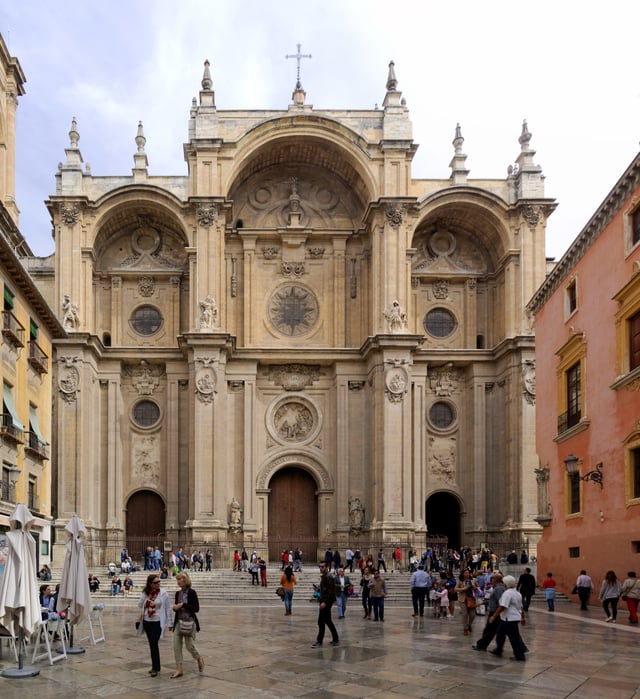
Cathedral of Granada, south portal
The cathedral of Granada is built over the Nasrid Great Mosque of Granada, in the centre of the city. Its construction began during the Spanish Renaissance in the early 16th century, shortly after the conquest of Granada by the Catholic Monarchs, who commissioned the works to Juan Gil de Hontañón and Enrique Egas. Numerous grand buildings were built in the reign of Charles V, Holy Roman Emperor, so that the cathedral is contemporary to the Christian palace of the Alhambra, the University and the Real Chancillería (Supreme Court).
The church was conceived on the model of the Cathedral of Toledo, for what initially was a Gothic architectural project, as was customary in Spain in the early decades of the 16th century. However, Egas was relieved by the Catholic hierarchy in 1529, and the continuation of the work was assigned to Diego Siloe, who built upon the example of his predecessor, but changed the approach towards a fully Renaissance aesthetic.[19]
The architect drew new Renaissance lines for the whole building over the gothic foundations, with an ambulatory and five naves instead of the usual three.
Over time, the bishopric continued to commission new architectural projects of importance, such as the redesign of the main façade, undertaken in 1664 by Alonso Cano (1601–1667) to introduce Baroque elements. In 1706 Francisco de Hurtado Izquierdo and later his collaborator José Bada built the current tabernacle of the cathedral.
Highlights of the church's components include the main chapel, where may be found the praying statues of the Catholic Monarchs, which consists of a series of Corinthian columns with the entablature resting on their capitals, and the vault over all. The spaces of the walls between the columns are perforated by a series of windows. The design of the tabernacle of 1706 preserves the classic proportions of the church, with its multiple columns crossing the forms of Diego de Siloé.[20]
Royal Chapel
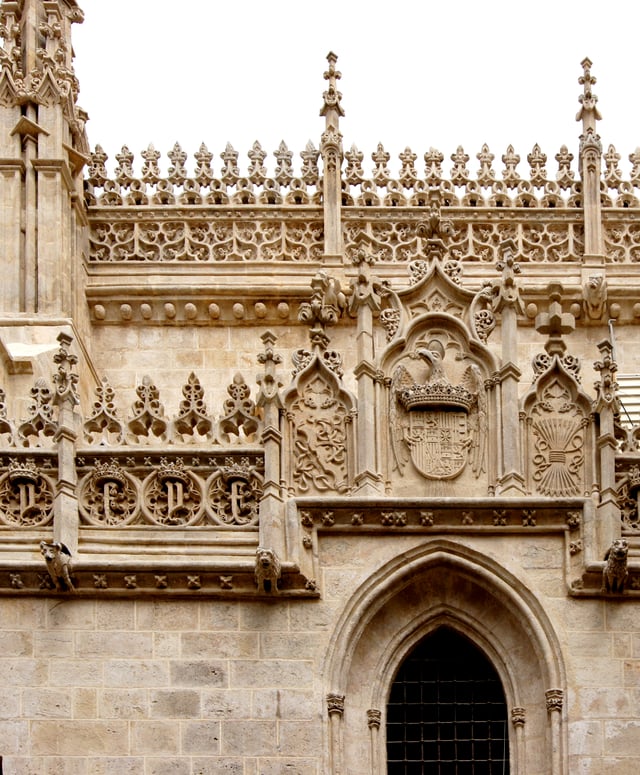
Royal Chapel of Granada
The Catholic Monarchs chose the city of Granada as their burial site by a royal decree dated September 13, 1504. The Royal Chapel of Granada, built over the former terrace of the Great Mosque, ranks with other important Granadan buildings such as the Lonja and the Catedral e Iglesia del Sagrario. In it are buried the Catholic Monarchs, their daughter Joanna of Castile (Juana la Loca) and her husband Felipe I (Felipe el Hermoso). Construction of the Chapel started in 1505, directed by its designer, Enrique Egas. Built in several stages, the continuing evolution of its design joined Gothic construction and decoration with Renaissance ideals, as seen in the tombs and the 17th and 18th century Granadan art in the Chapel of Santa Cruz. Over the years the church acquired a treasury of works of art, liturgical objects and relics.
The Royal Chapel was declared a Historic Artistic Monument on May 19, 1884, taking consideration of BIC (Bien de Interés Cultural) status in the current legislation of Spanish Historical Heritage (Law 16/1985 of 25 June). The most important parts of the chapel are its main retable, grid and vault. In the Sacristy-Museum is the legacy of the Catholic Monarchs. Its art gallery is highlighted by works of the Flemish, Italian and Spanish schools.[21]
Albayzín
The Albayzín (or Albaicín) is a neighborhood of Al-Andalus origin, much visited by tourists who flock to the city because of its historical associations, architecture, and landscape.
The archeological findings in the area show that it has been inhabited since ancient times.
It became more relevant with the arrival of the Zirid dynasty, in 1013, when it was surrounded by defensive walls. It is one of the ancient centres of Granada, like the Alhambra, the Realejo and the Arrabal de Bib-Rambla, in the flat part of the city. Its current extension runs from the walls of the Alcazaba to the cerro of San Miguel and on the other hand, from the Puerta de Guadix to the Alcazaba.
This neighborhood had its greatest development in the Nasrid era, and therefore largely maintains the urban fabric of this period, with narrow streets arranged in an intricate network that extends from the upper area, called San Nicolás, to the river Darro and Calle Elvira, located in the Plaza Nueva. The traditional type of housing is the Carmen granadino, consisting of a free house surrounded by a high wall that separates it from the street and includes a small orchard or garden.
In the Muslim era the Albayzín was characterized as the locus of many revolts against the caliphate.
At that time it was the residence of craftsmen, industrialists and aristocrats. With the Christian reconquest, it would progressively lose its splendor. The Christians built churches and settled there the Real Chancillería. During the rule of Felipe II of Spain, after the rebellion and subsequent expulsion of the Moors, the district was depopulated. In 1994 it was declared a Unesco World Heritage Site.[22] Of its architectural wealth among others include the Ziri walls of the Alcazaba Cadima, the Nasrid walls, the towers of the Alcazaba, the churches of Salvador (former main mosque), San Cristóbal, San Miguel Alto and the Real Chancillería.[23]
Sacromonte
The Sacromonte neighbourhood is located on the Valparaíso hill, one of several hills that make up Granada.
This neighborhood is known as the old neighbourhood of the Romani, who settled in Granada after the conquest of the city. It is one of the most picturesque neighborhoods, full of whitewashed caves cut into the rock and used as residences. The sound of strumming guitars may still be heard there in the performance of flamenco cantes and quejíos, so that over time it has become one of the most popular tourist attractions in Granada.
At the top of this hill is the Abbey of Sacromonte and the College of Sacromonte, founded in the 17th century by the then Archbishop of Granada Pedro de Castro. The Abbey of Sacromonte was built to monitor and guard the alleged relics of the evangelists of Baetica. Those are of questionable authenticity, but since their finding the area has been a religious pilgrimage destination.[24]
The abbey complex consists of the catacombs, the abbey (17th–18th centuries), the Colegio Viejo de San Dionisio Areopagita (17th century) and the Colegio Nuevo (19th century).
The interior of the church is simple and small but has numerous excellent works of art, which accentuate the size and rich carving of the Crucificado de Risueño, an object of devotion for the Romani people, who sing and dance in the procession of Holy Week. The facilities also include a museum, which houses the works acquired by the Foundation.[25]
Charterhouse
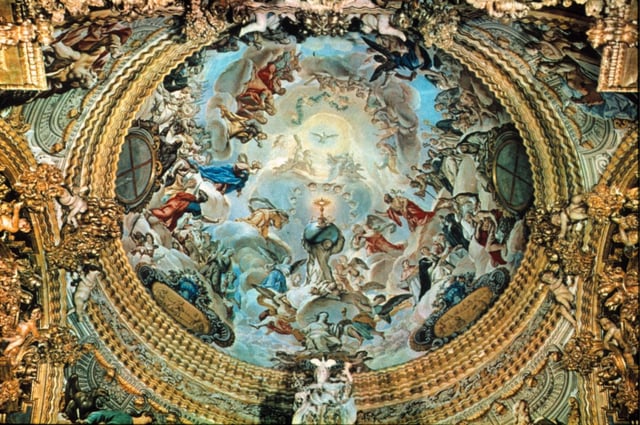
Tabernacle Dome, Granada Charterhouse.
The Charterhouse of Granada is a monastery of cloistered monks, located in what was a farm or Muslim almunia called Aynadamar ("fountain of tears") that had an abundance of water and fruit trees. The initiative to build the monastery in that place was begun by Gonzalo Fernández de Córdoba, known as El Gran Capitán. The charterhouse was founded in 1506; construction started ten years later, and continued for the following 300 years.
The Monastery suffered heavy damage during the Peninsular War and lost considerable property in 1837 as a result of the confiscations of Mendizábal. Currently, the monastery belongs to the Carthusians, reporting directly to the Archdiocese of Granada.[26]
The street entrance to the complex is an ornate arch of Plateresque style. Through it one reaches a large courtyard, at the end which is a wide staircase leading to the entrance of the church. The church, of early 16th century style and plan, has three entrances, one for the faithful and the other two for monks and clergy. Its plan has a single nave divided into four sections, highlighting the retables of Juan Sánchez Cotán and the chancel's glass doors, adorned with mother-of-pearl, silver, rare woods and ivory. The presbytery is covered by elliptical vaulting. The main altar, between the chancel arch and the church tabernacle, is gilded wood.
The church's tabernacle and sancta sanctorum are considered a masterpiece of Baroque Spanish art in its blend of architecture, painting and sculpture. The dome that covers this area is decorated with frescoes by the Córdoba artist Antonio Palomino (18th century) representing the triumph of the Church Militant, faith, and religious life.
The courtyard, with galleries of arches on Doric order columns opening on it, is centered by a fountain. The Chapter House of Legos is the oldest building of the monastery (1517). It is rectangular and covered with groin vaulting.[27]
Mosque of Granada
The Mosque of Granada was inaugurated in 2003 on the summit of the neighborhood of Albayzin.
The mosque was built near the Church of San Salvador and the Church of San Nicolás.
The Church of San Salvador was built on the site of the Great Mosque of Albayzin.
The Society for the Return of Islam in Spain purchased the site in 1981, but it took many years for the plans to be approved.
The mosque's initial funding was supplied by Shaykh 'Abdalqadir as-Sufi al-Murabit who envisioned providing Granada's new Spanish Muslim community with a mosque. Additional funding came from Malaysia, Morocco and the United Arab Emirates. In 1991 the CIE (Comunidad Islámica en España) hired the architect Renato Ramirez Sanchez to design the mosque. In the 1990s, there was a heated debate pertaining to the design of the minaret. Construction eventually began in 2001. The mosque now serves about 500 people.[28]
Palace of the Marqués de Salar
The Palace of the Marqués de Salar was built in one of the most emblematic streets of Granada, the Carrera del Darro, at number 5. This place is an architectural example of the classical Granada during the Renaissance transformation of the XVIth century. It was built by the Marqués de Salar, great-grandson of both Hernán Pérez del Pulgar (known by the name of El de la Hazañas [The One of the Valiant Deeds]) and Gonzalo Fernández de Córdoba (El Gran Capitán [The Great Captain]), Captain-General of the Castilian-Aragonese forces that concluded the Reconquest of the peninsula. The palace is now the museum of perfumes El Patio de los Perfumes [49], with 1,500 square metres (16,000 sq ft) of floor space on two floors and 130 square metres (1,400 sq ft) of patio to relax surrounded by flowers and perfumes.
Other buildings
Monasterio de San Jerónimo: monastery
San Juan de Dios Hospital
Castril Palace
Museo de Bellas Artes de Granada
Madrasah of Granada
Districts
Realejo
Realejo was the Jewish district in the time of the Nasrid Granada.
(This is centuries since the Jewish population was so important that Granada was known in Al-Andalus under the name of "Granada of the Jews", Arabic: غرناطة اليهود Gharnāṭah al-Yahūd.) It is today a district made up of many Granadinian villas, with gardens opening onto the streets, called Los Cármenes.
Cartuja
This district contains the Carthusian monastery of the same name: Cartuja.
This is an old monastery started in a late Gothic style with Baroque exuberant interior decorations.
In this district also, many buildings were created with the extension of the University of Granada.
Bib-Rambla
The toponym derives from a gate (Bab al-Ramla, or the Gate of the Ears) that was built when Granada was controlled by the Nasrid dynasty. Nowadays, Bib-Rambla is a high point for gastronomy, especially in its terraces of restaurants, open on beautiful days. The Arab bazaar (Alcaicería) is made up of several narrow streets, which start from this place and continue as far as the cathedral
Sacromonte
The Sacromonte neighborhood is located on the extension of the hill of Albaicín, along the Darro River.
This area, which became famous by the nineteenth century for its predominantly Gitano inhabitants, is characterized by cave houses, which are dug into the hillside. The area has a reputation as a major center of flamenco song and dance, including the Zambra Gitana*]], an Andalusian dance originating in the Middle East. The zone is a protected cultural environment under the auspices of the* Centro de Interpretación del Sacromonte*, a cultural center dedicated to the preservation of Gitano cultural forms.
Albayzín
Albayzín (also written as Albaicín), located on a hill on the right bank of the river Darro, is the ancient Moorish quarter of the city and transports the visitor to a unique world: the site of the ancient city of Elvira, so-called before the Zirid Moors
Zaidín

A panoramic view from Alhambra
This formerly blue collar but now upmarket neighborhood houses 100,000 residents of Granada, making it the largest neighborhood or 'barrio'.
Traditionally populated by Romani people, now many residents are from North and West Africa, China, and many South American countries. Every Saturday morning it hosts a large outdoor market or "mercadillo", where many people come and sell their wares of fruits and vegetables, clothes and shoes, and other odds and ends.
Parks and gardens in Granada
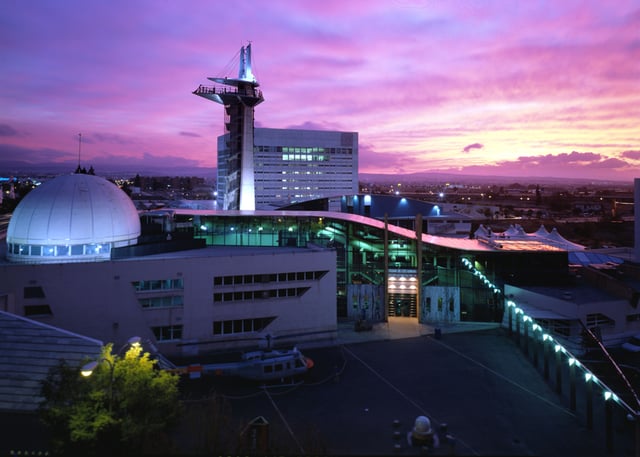
The Granada Science Park.
The city of Granada has a significant number of parks and gardens, including:[29]
Climate

A panoramic view of Granada city, 2013
Granada has a hot-summer Mediterranean climate (Csa) close to a cold semi-arid climate (BSk) Summers are hot and dry with daily temperatures averaging 34 °C (93 °F) in the hottest month (July); however, temperatures reaching over 40 °C (104 °F) are not uncommon in the summer months. Winters are cool and damp, with most of the rainfall concentrated from November through to January. The coldest month is January with daytime temperatures hovering at 13 °C (55 °F) and dropping to around 1 °C (34 °F) during the night. Frost is quite common as temperatures usually reach below-freezing in the early morning. Spring and autumn are unpredictable, with temperatures ranging from mild to warm. Early summer in 2017 confronted the city with two massive heat waves that broke long-standing record temperatures starting on June 13, 2017, with a new maximum high for the month at 40.6 °C (old record 40.0), which was topped three times within the span of four days at 40.9 °C on June 14, 41.3 (June 15) and, eventually, 41.5 (June 17). The first two days of this heat wave ranked Granada first in both Spain and Europe, making it the hottest place on the given days. The second extreme surge in temperatures followed roughly a month later when readings soared to 45.7 and 45.3 °C on July 12 and 13, respectively, surpassing the old July record by almost 3 degrees.
| Climate data for Granada (Granada Base Aérea, altitude 687 m, 2,254 ft) | |||||||||||||
|---|---|---|---|---|---|---|---|---|---|---|---|---|---|
| Month | Jan | Feb | Mar | Apr | May | Jun | Jul | Aug | Sep | Oct | Nov | Dec | Year |
| Record high °C (°F) | 23.4(74.1) | 27.6(81.7) | 29.1(84.4) | 31.9(89.4) | 38.6(101.5) | 40.2(104.4) | 43.5(110.3) | 42.0(107.6) | 40.6(105.1) | 35.2(95.4) | 27.6(81.7) | 24.8(76.6) | 43.5(110.3) |
| Average high °C (°F) | 12.6(54.7) | 14.6(58.3) | 18.0(64.4) | 19.5(67.1) | 24.0(75.2) | 30.2(86.4) | 34.2(93.6) | 33.5(92.3) | 28.7(83.7) | 22.6(72.7) | 16.5(61.7) | 13.1(55.6) | 22.3(72.1) |
| Daily mean °C (°F) | 6.9(44.4) | 8.5(47.3) | 11.4(52.5) | 13.1(55.6) | 17.1(62.8) | 22.5(72.5) | 26.0(78.8) | 25.5(77.9) | 21.6(70.9) | 16.3(61.3) | 10.9(51.6) | 7.9(46.2) | 15.7(60.3) |
| Average low °C (°F) | 1.2(34.2) | 2.4(36.3) | 4.8(40.6) | 6.8(44.2) | 10.2(50.4) | 14.7(58.5) | 17.7(63.9) | 17.6(63.7) | 14.4(57.9) | 10.1(50.2) | 5.3(41.5) | 2.7(36.9) | 9.0(48.2) |
| Record low °C (°F) | −12.6(9.3) | −13.4(7.9) | −6.4(20.5) | −1.9(28.6) | 0.6(33.1) | 5.6(42.1) | 9.0(48.2) | 8.2(46.8) | 1.2(34.2) | −0.5(31.1) | −4.5(23.9) | −8.6(16.5) | −13.4(7.9) |
| Averageprecipitationmm (inches) | 41(1.6) | 33(1.3) | 35(1.4) | 37(1.5) | 30(1.2) | 11(0.4) | 2(0.1) | 3(0.1) | 23(0.9) | 38(1.5) | 50(2.0) | 50(2.0) | 353(14) |
| Average precipitation days | 5.8 | 5.6 | 5.1 | 6.3 | 4.7 | 1.7 | 0.3 | 0.6 | 2.7 | 5.1 | 6.7 | 7.2 | 51.8 |
| Average snowy days | 0.7 | 0.5 | 0.2 | 0.1 | 0 | 0 | 0 | 0 | 0 | 0 | 0.1 | 0.3 | 2 |
| Averagerelative humidity(%) | 72 | 68 | 60 | 57 | 51 | 43 | 37 | 41 | 51 | 62 | 71 | 75 | 57 |
| Mean monthlysunshine hours | 170 | 172 | 219 | 234 | 280 | 331 | 362 | 330 | 254 | 211 | 164 | 148 | 2,881 |
| Source:Agencia Estatal de Meteorología[30][31] | |||||||||||||
| Climate data for Granada (Granada Airport, altitude 567 m, 1,860 ft) | |||||||||||||
|---|---|---|---|---|---|---|---|---|---|---|---|---|---|
| Month | Jan | Feb | Mar | Apr | May | Jun | Jul | Aug | Sep | Oct | Nov | Dec | Year |
| Record high °C (°F) | 24.6(76.3) | 26.2(79.2) | 31.2(88.2) | 32.7(90.9) | 39.5(103.1) | 42.6(108.7) | 45.7(114.3) | 43.0(109.4) | 43.1(109.6) | 33.5(92.3) | 27.4(81.3) | 24.5(76.1) | 45.7(114.3) |
| Average high °C (°F) | 13.0(55.4) | 15.4(59.7) | 19.0(66.2) | 20.6(69.1) | 25.0(77.0) | 31.0(87.8) | 34.8(94.6) | 34.2(93.6) | 29.4(84.9) | 23.2(73.8) | 17.0(62.6) | 13.4(56.1) | 23.0(73.4) |
| Daily mean °C (°F) | 6.6(43.9) | 8.5(47.3) | 11.4(52.5) | 13.3(55.9) | 17.2(63.0) | 22.3(72.1) | 25.3(77.5) | 24.8(76.6) | 21.1(70.0) | 16.0(60.8) | 10.6(51.1) | 7.6(45.7) | 15.4(59.7) |
| Average low °C (°F) | 0.3(32.5) | 1.6(34.9) | 3.8(38.8) | 6.0(42.8) | 9.4(48.9) | 13.6(56.5) | 15.7(60.3) | 15.5(59.9) | 12.8(55.0) | 8.7(47.7) | 4.2(39.6) | 1.7(35.1) | 7.8(46.0) |
| Record low °C (°F) | −14.2(6.4) | −10.0(14.0) | −7.6(18.3) | −3.2(26.2) | −0.2(31.6) | 5.0(41.0) | 6.4(43.5) | 6.6(43.9) | 3.6(38.5) | −2.6(27.3) | −6.4(20.5) | −9.2(15.4) | −14.2(6.4) |
| Averageprecipitationmm (inches) | 42(1.7) | 38(1.5) | 32(1.3) | 36(1.4) | 28(1.1) | 11(0.4) | 2(0.1) | 4(0.2) | 19(0.7) | 40(1.6) | 54(2.1) | 56(2.2) | 365(14.4) |
| Average precipitation days | 5.6 | 5.9 | 4.9 | 6.2 | 4.2 | 1.7 | 0.3 | 0.6 | 2.8 | 5.0 | 6.8 | 7.4 | 52.1 |
| Mean monthlysunshine hours | 165 | 172 | 225 | 231 | 293 | 336 | 373 | 344 | 262 | 215 | 170 | 149 | 2,935 |
| Source:Agencia Estatal de Meteorología[32][33] | |||||||||||||
Notable people
Judah ben Saul ibn Tibbon (1120–1190), translator and physician
Al-Zuhri (fl. 1130s–1150s), geographer
Ibn Sa'id al-Maghribi (1213–1286), geographer, historian and poet
Álvaro de Bazán (1526–1588), admiral
Alonso Cano (1601–1667), painter, sculptor and architect
Pedro de Mena (1628–1688), baroque sculptor
José de Mora (1642–1724), baroque sculptor
Francisco Martínez de la Rosa (1787–1862), statesman, politician, dramatist and poet
Ángel Ganivet (1865–1898), writer and dramatist
Mariana Pineda (1804–1831), liberalist heroine
Eugenia de Montijo (1826–1920), last Empress consort of France
Mariano Fortuny y Madrazo (1871–1949), painter, photographer, designer and scenographer
Pablo de Loyzaga (1872–1951), sculptor and professor of fine arts
Emilio Herrera Linares (1879–1967), military engineer and physicist
Melchor Fernández Almagro (1893–1966), literary critic, historian and journalist
Federico García Lorca (1898–1936), poet and dramatist
Francisco Ayala (1906–2009), writer and critic
Luis Rosales Camacho (1910–1992), poet and essayist from the Generation of '36
José Tamayo (1920–2003), theatre director
Manuel Jiménez de Parga (b. 1929), lawyer, politician, diplomat and jurist
Miguel Ríos (born 1944) rock singer and composer
Carlos Cano (1946–2000), singer-songwriter
Manuel Orantes (born 1949), tennis player
Javier Egea (1952–1999), considered one of the most important Spanish poets of the 1980s
Luis García Montero (born 1958), poet and literary critic
Chus Gutiérrez (born 1962), film director, actress and journalist
María José Rienda Contreras (born 1975), ski racer
Pablo Aguilar Bermúdez (born 1989), basketball player
Lidia Redondo (born 1992), gymnast
Sam Hidalgo-Clyne (born 1993), Scotland international rugby union player (born in Granada, but moved to Scotland at age 3)
It is the subject of the 1967 song "Vuelvo a Granada" by Miguel Ríos.[34]
Transport
Construction of a light rail network, the Granada metro, began in 2007. It was greatly delayed by the Spanish economic crisis; service finally started on 21 September 2017.[35] It crosses Granada and covers the towns of Albolote, Maracena and Armilla. Other transportation options in the city of Granada are trains, taxis or buses.
Bus
The main company operating bus transport in Granada is Transportes Rober.
There is also bus transportation to and from the airport with the company Alsa.
Train
Granada railway station has rail connections with many cities in Spain. There are several types of train service to and from Granada[36]
Short distance trains
Medium distance trains
Long distance trains
AVE (high speed long distance) via the Antequera–Granada high-speed rail line. The closest AVE connection is in Antequera.
Taxi
Granada has a wide network of taxis to help travellers reach their destinations.
Official Granada taxis are white with a green stripe.
Airport
The nearest airport is Federico García Lorca Airport, about 15 km (9 mi) west of Granada.
Granada Public Transportation Statistics
The average amount of time people spend commuting with public transit in Granada, for example to and from work, on a weekday is 42 min.
9% of public transit riders, ride for more than 2 hours every day.
The average amount of time people wait at a stop or station for public transit is 10 min, while 8% of riders wait for over 20 minutes on average every day.
The average distance people usually ride in a single trip with public transit is 2.7 km, while 0% travel for over 12 km in a single direction.[37]
Sports
Granada has a football team:
Granada CF, in the La Liga
Granada has a basketball team:
Fundación CB Granada, in LEB Oro
Skiing:
FIS Alpine World Ski Championships 1996
Twin towns and sister cities
Granada shares twin cities status with these cities:[38]
Aix-en-Provence, France, 1979[38]
[[INLINE_IMAGE|//upload.wikimedia.org/wikipedia/commons/thumb/2/2c/Flag_of_Morocco.svg/23px-Flag_of_Morocco.svg.png|//upload.wikimedia.org/wikipedia/commons/thumb/2/2c/Flag_of_Morocco.svg/35px-Flag_of_Morocco.svg.png 1.5x, //upload.wikimedia.org/wikipedia/commons/thumb/2/2c/Flag_of_Morocco.svg/45px-Flag_of_Morocco.svg.png 2x|Morocco|h15|w23|thumbborder flagicon-img flagicon-img]] Tetuán, Morocco, 1988[38]
Tlemcen, Algeria, 1989[38]
[[INLINE_IMAGE|//upload.wikimedia.org/wikipedia/en/thumb/a/a4/Flag_of_the_United_States.svg/23px-Flag_of_the_United_States.svg.png|//upload.wikimedia.org/wikipedia/en/thumb/a/a4/Flag_of_the_United_States.svg/35px-Flag_of_the_United_States.svg.png 1.5x, //upload.wikimedia.org/wikipedia/en/thumb/a/a4/Flag_of_the_United_States.svg/46px-Flag_of_the_United_States.svg.png 2x|United States|h12|w23|thumbborder flagicon-img flagicon-img]] Coral Gables, Florida, United States, 1989[38][39]
Freiburg im Breisgau, Germany, 1991[38]
[[INLINE_IMAGE|//upload.wikimedia.org/wikipedia/commons/thumb/2/2c/Flag_of_Morocco.svg/23px-Flag_of_Morocco.svg.png|//upload.wikimedia.org/wikipedia/commons/thumb/2/2c/Flag_of_Morocco.svg/35px-Flag_of_Morocco.svg.png 1.5x, //upload.wikimedia.org/wikipedia/commons/thumb/2/2c/Flag_of_Morocco.svg/45px-Flag_of_Morocco.svg.png 2x|Morocco|h15|w23|thumbborder flagicon-img flagicon-img]] Marrakech, Morocco, 1994[38]
Belo Horizonte, Brazil, 2002[38]
[[INLINE_IMAGE|//upload.wikimedia.org/wikipedia/commons/thumb/c/cb/Flag_of_the_United_Arab_Emirates.svg/23px-Flag_of_the_United_Arab_Emirates.svg.png|//upload.wikimedia.org/wikipedia/commons/thumb/c/cb/Flag_of_the_United_Arab_Emirates.svg/35px-Flag_of_the_United_Arab_Emirates.svg.png 1.5x, //upload.wikimedia.org/wikipedia/commons/thumb/c/cb/Flag_of_the_United_Arab_Emirates.svg/46px-Flag_of_the_United_Arab_Emirates.svg.png 2x|United Arab Emirates|h12|w23|thumbborder flagicon-img flagicon-img]] Sharjah, United Arab Emirates, 2009[40]
See also
Gate of the Ears
Rafael Guillén
El Fandi
History of the Jews in Spain
Synod of Elvira
Memories of the Alhambra
